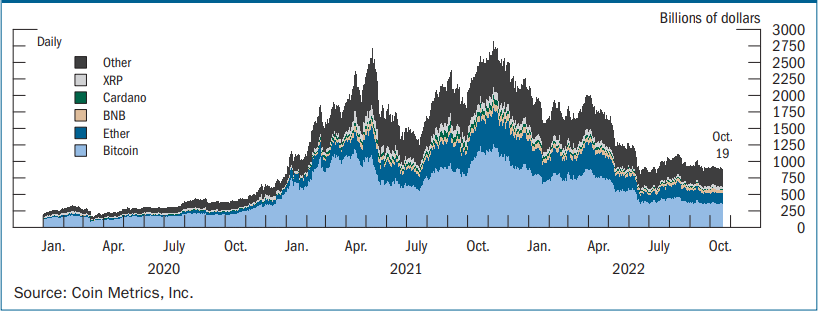Activities in the digital assets can pose challenges to financial stability, the U.S. Federal Reserve noted.
However, developments in recent months suggest that the ecosystem faces vulnerabilities and risks similar to those that can occur in traditional finance, such as runs, excessive leverage, operational risk, opacity and fraud.
As such, the Fed believed that acting now to promote an appropriate regulatory environment for the digital asset ecosystem will help support responsible innovation and preserve financial stability.
Market capitalization of selected crypto-assets.
Speculation and risk appetite appear to be the main driving forces behind crypto-asset prices, which have seen large swings in recent years.
The chart below shows the market capitalization of selected crypto-assets (excluding stablecoins), which is currently approximately 69% below its November 2021 peak.
Digital assets
Stablecoins, too, have experienced significant volatility over the past year, including, in some cases, runs .
For example, according to the Fed, TerraUSD was a stablecoin with a market capitalization of about $18 billion prior to its collapse in May 2022.
TerraUSD largely lacked assets to back its value and, like many other stablecoins, its demand was driven primarily by the yield investors could earn.
Amid a reduction in loan rates earned by TerraUSD holders in the months leading up to May and temporary liquidity shortages, concerns about TerraUSD’s stability precipitated a run and complete collapse in a matter of days.
The collapse of the Terra blockchain was followed by stresses across the entire digital asset ecosystem, highlighting vulnerabilities and interconnections in the space.
Several entities that had direct exposures to TerraUSD or engaged in speculative bets on other cryptoassets found themselves in financial distress, sometimes even bankruptcy.
The events surrounding TerraUSD may also have led to a temporary loss of confidence in another stablecoin, Tether, which briefly traded below par.
The market capitalization of stablecoins has declined about 22% since its peak in April 2022, with nearly half of the decline corresponding to the collapse of TerraUSD.
The aftermath of the turmoil that began in May has also severely reduced activity in decentralized funding protocols (DeFi).
![]()

